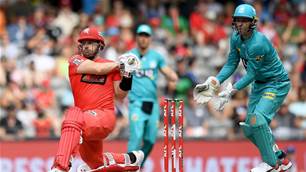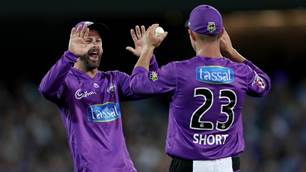It is something that permeates throughout Asian franchise cricket but is now coming to Australian shores this summer.
The Big Bash League is adopting the Strategic Time Out (STO) for BBL09.
Those 90 seconds of ‘joy’ for spectators, and viewers, waiting for the teams to work out what’s going right and wrong.
Initially conceived in 2009, the STO has been developed over time. And when I say developed, the time taken has been reduced but still maximises marketing opportunity.
Analysts must have calculated the point of diminishing return (surely, it is zero?) and set the STO to one minute and thirty seconds.
When watching a game and you feel that the STO is taking too long, think back to those early days in 2009 when the IPL first introduced the concept. Seven-and-a-half minutes. 420 seconds. Not so bad now, is it?
For this year’s Big Bash League, Cricket Australia have adopted the STO concept. Their Head of Big Bash Leagues, Alistair Dobson, has enthused over the idea.
Cricket fans can watch the BBL live on Kayo Sports
click here for a free two-week trial!
“The Strategic Time Out has been thought about and developed over the last couple of years, with input from key stakeholders in the game”, said Dobson. Perhaps a thesaurus is required at Jolimont Street to help with synonyms for ‘sponsors’ though.
Dobson continued: “We’ve seen the strategic time outs used in other T20 competitions around the world, and we feel that providing the batting team with the power to call a time out will add an extra tactical dimension to the outcome of the game, with the priority of maximising runs.”
Definitely for the tactics and strategy then; nothing whatsoever to do with commercial revenue streams. Glad we cleared that up.
So, let us dip into the revised playing conditions for the 2019-20 BBL campaign and have a look at the detail for STOs:
11.5.1 In any innings where the number of overs is scheduled to be 16 or greater, there shall be a 90 second Strategic Time Out (“STO”) taken at the request of the batting team, commencing from the time the umpire calls and signals that the STO is being taken. Umpires will return to their on-field positions for play to resume at the end of 90 seconds.
That’s clear enough. Now we know when they are available, how long they are, who can call one and what happens when they do. All in one neatly explained paragraph. Well, no. There is more so let us plough on…
11.5.2 During the STO no practice by the players is permitted on the field.
It says ‘no practice’ but doesn’t specify what constitutes practice. Is a bout of shadow batting going to fall foul? And what happens if you do practice? Sounds like a potential rabbit hole.
11.5.3 During the STO members of the coaching and support staff of both teams are permitted to enter the playing field to address their players. Players not presently on the field can also enter the field.
TIME FOR A PAR-TAY!!! Everyone is welcome, as long as they are on the same team, for a quick chat before carrying on. The coaches can impart nuggets of wisdom like “why are you bowling like a clown?” and other such insights.
11.5.4 Where the STO applies in an innings, it shall be taken at the end of an over and shall be taken between the end of the 7th and the end of the 13th over inclusive
Well, that is nice. Just at the time that the television viewers have finished their latest beverage and are in need of a new one. Enough of a gap to head to the toilet and sweep past the fridge for another cold beer, in the case of Australian fans, before hitting the sofa for the next over. If not, you can sit there and be marketed at.
11.5.5 The STO shall be requested by the batting team captain, batting team coach or either batter at the wicket by notifying one of the two on field umpires or the fourth umpire
I guess that it’s much easier for the batters to signal to the umpires. What if the coach decides it? How does he communicate that? That could be a bit tricky with all those pyrotechnics going off. Can’t really see Darren Lehmann sprinting onto the field at the Gabba to signal an STO to the umpires. What if he isn’t seen in time? This is getting tricky now, let’s read on.
11.5.5.1 For the request to be considered for the calling of the STO by the umpire at the completion of the over in progress, the request must be made prior to the bowler commencing his run up or if he has no run up, his bowling action for the final ball of the over in progress
The bowler not having a run up? Even Phil Tufnell, the least athletic cricketer ever to grace a cricket field, had a run up. It wasn’t a huge run up for sure; more of a jaunty little skip towards the crease that was clearly a precursor for Strictly Come Dancing. However, it was a run up. Perhaps the legislators are trying to stop a contrived, Greg Chappell-esque attempt to circumvent the rules? Such as carrying Rashid Khan on your shoulders to the bowling crease and then slinging him, like a trebuchet, towards the awaiting batter?
11.5.5.2 If the batting side does not request the STO by the 12.5 over mark then it will be taken at the end of the 13th over.
There will be room for cynical marketing whether the two captains agree to it, or not. Perhaps cricket could borrow from baseball and its ‘seventh-inning stretch’ ritual. Ideal time to create a song, much in the same vein as ‘C’mon Aussie C’mon’, but with even more sponsor-inspired enthusiasm.
For sake of clarity, no other team representative is permitted to request the time out.
Err, OK…the mascot is not allowed. So, don’t even try it.
11.5.6 The umpires shall call and signal the STO by tapping a raised wrist at the time the STO is requested, and at the beginning of the STO.
The signal from the umpires to mark the time out is to gesture like a disapproving schoolteacher waiting at the gates for those who missed the bus or couldn’t get out of bed. Another great marketing opportunity – the ‘Official Watch Partner’, because that’s what they would be called, would provide wristwatches for the umpires. If the supplier made the watch faces large enough, for their logos to be visual on cameras, it could double for some sort of arm guard protection. Bruce Oxenford would be all over one of those.
11.5.7 For any innings reduced to 15 overs or less, no STO will be available.
Don’t worry potential partners that is what the rain break filler section is for. The other message to take from this is that teams aren’t strategic in less than 16 overs. Wait, that is 96 balls…maybe the ECB’s plan IS to bring a game to the masses while not losing the strategic element. Add another four balls, and we’re there.
So, there we have the rules of the Strategic Time Out for this year’s BBL. The conclusion is that we have a period of time for teams to re-group; reset the game plan or finely tune to maximise the game position. Honest. If not, don’t fret because the STO will gone in 90 seconds.
Cricket fans can watch the BBL live on Kayo Sports
click here for a free two-week trial!
Related Articles

Sutherland using women’s cricket experience for golf

Heat Defeat sees Thunder Make the Finals














